Saving What’s Left of R.I.’s Natural Heritage Will Take Collaboration
Updating what needs to be protected and where is the first step
November 7, 2022
When Rhode Island Department of Environmental Management experts Rick Enser and Chris Raithel went their separate ways 15 years ago, the system designed to protect Ocean State biodiversity was left rudderless. The Natural Heritage Program they built and ran still hasn’t recovered.
Their office within DEM documented the state’s biodiversity and provided guidance for the preservation of rare, endangered, and threatened species, both plant and animal. But DEM’s involvement in the work required to track and protect at-risk species regressed in 2007 — the program a victim of budget cuts and a shift to making state-protected open space more recreational friendly.
When the state essentially scrapped a program most environmentalists consider vital, Enser, an ecologist and botanist who coordinated the office for more than 25 years, retired. Raithel, the program’s zoologist, became the non-game and endangered species biologist for DEM’s Division of Fish and Wildlife until his retirement in 2018.
An agreement between DEM, The Nature Conservancy, and the Rhode Island Natural History Survey left the management of the program’s species database to the latter, a small Kingston-based nonprofit with a handful of full-time staffers and a budget far less than that of DEM. David Gregg, the organization’s executive director, said the Survey doesn’t have the power to add or remove species from the list, nor does it have regulatory authority. He said the staff has the knowledge to manage the database and the experience to help track and map species in need of protection, but promised funding never materialized.
With funding severely limited, the program and the information it contains has remained stuck in the past. Kate McPherson, the Narragansett Bay riverkeeper for Save The Bay, recently told ecoRI News that Rhode Island can’t offer any real protection “if we don’t know what needs to be protected.” She said updating the rare species lists would be “super helpful.”
The list of Rare Native Animals of Rhode Island was last updated in March 2006. The state’s rare plant list was last updated in 2016, thanks to Enser’s work on the Rhode Island Wildlife Action Plan. Before the Natural Heritage Program was dismantled, the lists were updated every few years for nearly three decades.
The program’s database, according to Gregg, is currently maintained on an Excel spreadsheet that is 42 columns wide, has 4,500 lines of observations, and is made up of 191,000 cells. It’s a difficult system to navigate, and much of the data it holds is outdated.
Gregg also believes the number of animals and plants identified, mapped, and tracked needs to expand, from the 500-plus currently listed to about a thousand. He said better understanding the role species play within an ecosystem is important, especially so during a climate crisis.
“We can’t be killing everything off but feel OK about it because there’s a park in the western part of the state where I can go,” Gregg said. “Biodiversity poverty needs to be avoided. Everybody understands that a rich, interesting, and diverse environment is better.”
To bring the state’s Natural Heritage Program into the 21st century, the Survey and DEM have applied for a $500,000 America the Beautiful Challenge grant that would help fund, among other things, the creation of updated rare species lists, a set of defensible criteria for adding and removing species, a transparent process to follow, and development of a database that can host information in a manner that is accessible and mapping-friendly.
Gregg said a decision on the grant is expected by the end of the year.
A national heritage program, which most states have, including Massachusetts and Connecticut, is a vital tool that provides contemporary information about known populations of rare animals and plants and identifies and maps the location of important habitats, including areas that may be used by rare animals for breeding, nesting, feeding, roosting, or overwintering.

Drowning salt marsh
Among the animals likely to be added to the state’s rare species list should it be updated is the saltmarsh sparrow.
This nondescript, hard-to-spot bird ekes out an existence in, well, salt marshes. These tiny songbirds, with dappled feathers, a white breast streaked with brown, and a radiant orange face, nest in high-marsh grasses just above the mean high-tide line. The species has naturally adapted to occasional flooding, as their eggs can survive short periods of inundation and chicks often climb to safety in the grass above the nest.
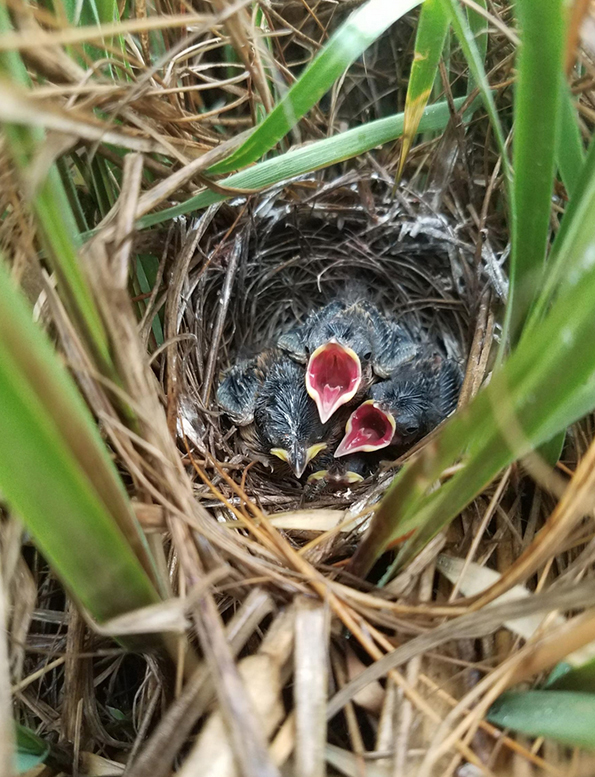
But even under conditions saltmarsh sparrows have evolved with — the species has built nests only an inch above the ground for thousands of years — nesting in an area that floods monthly at high tide is a risky move. To deal with breeding in an environment that habitually floods, the breeding season for saltmarsh sparrows is short, 28 days (a tide cycle) from eggs to vacating the nest.
But development and pollution, combined with increasing storm surge and sea-level rise being fueled by an intensifying climate crisis, has saltmarsh sparrows on the run.
More than a foot of sea-level rise in some parts of their range — the Mid-Atlantic to southern Maine coast — during the past century is causing nests to flood more frequently, overwhelming the species’ highly adaptive traits. Accelerated sea-level rise is projected throughout the remainder of this century.
While the U.S. Fish & Wildlife Service doesn’t currently list the saltmarsh sparrow as endangered or threatened, the federal agency has been assessing the species’ listing for the past few years. A new determination is expected in 2024.
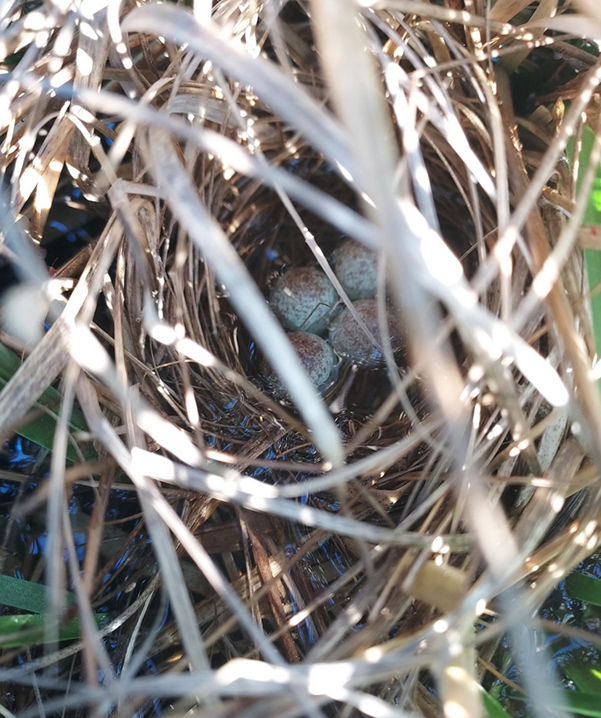
In its State of the Birds 2022, the National Audubon Society lists the saltmarsh sparrow as a species of “high conservation concern.” The report notes range-wide surveys suggest the global population declined by about 9% annually between the 1990s and early 2010s, reducing the population size by 75%, to 50,000-60,000 birds.
“Estimates of population growth, based on detailed demographic data, match this rate of decline, and projections accounting for sea-level rise suggest possible extinction by mid-century without management interventions,” according to the National Audubon Society.
Environmental organizations, such as Audubon societies, Save The Bay, and the Atlantic Coast Joint Venture, and overlooked volunteers are working to stem the tide. To halt the steep population decline and recover the saltmarsh sparrow population, humans must restore and enhance existing habitat to provide high-quality nesting areas on at least 84,000 acres of salt marsh and protect adjacent, inland areas to allow marshes to migrate as sea levels rise, according to the Atlantic Coast Joint Venture.
Wenley Ferguson, director of habitat restoration for Save The Bay, has spent much of her 26 years working for the Providence-based nonprofit digging shallow ditches — runnels — in Rhode Island salt marshes to drain excess water from a vital ecosystem experiencing more frequent flooding. She has witnessed firsthand the deteriorating health of an ecosystem that is a pivotal part of the food web and protects the built environment from storm surge and rising waters.
“There’s terrible conditions for nest success throughout the region,” Ferguson said.
Salt marsh deterioration, however, doesn’t just impact a soft-voiced bird that prefers to run through high grass than fly over it. The habitat itself is threatened, and other species that depend on it — willets, seaside sparrows, humans — will eventually feel the impact if these tidal marshes continue to drown.
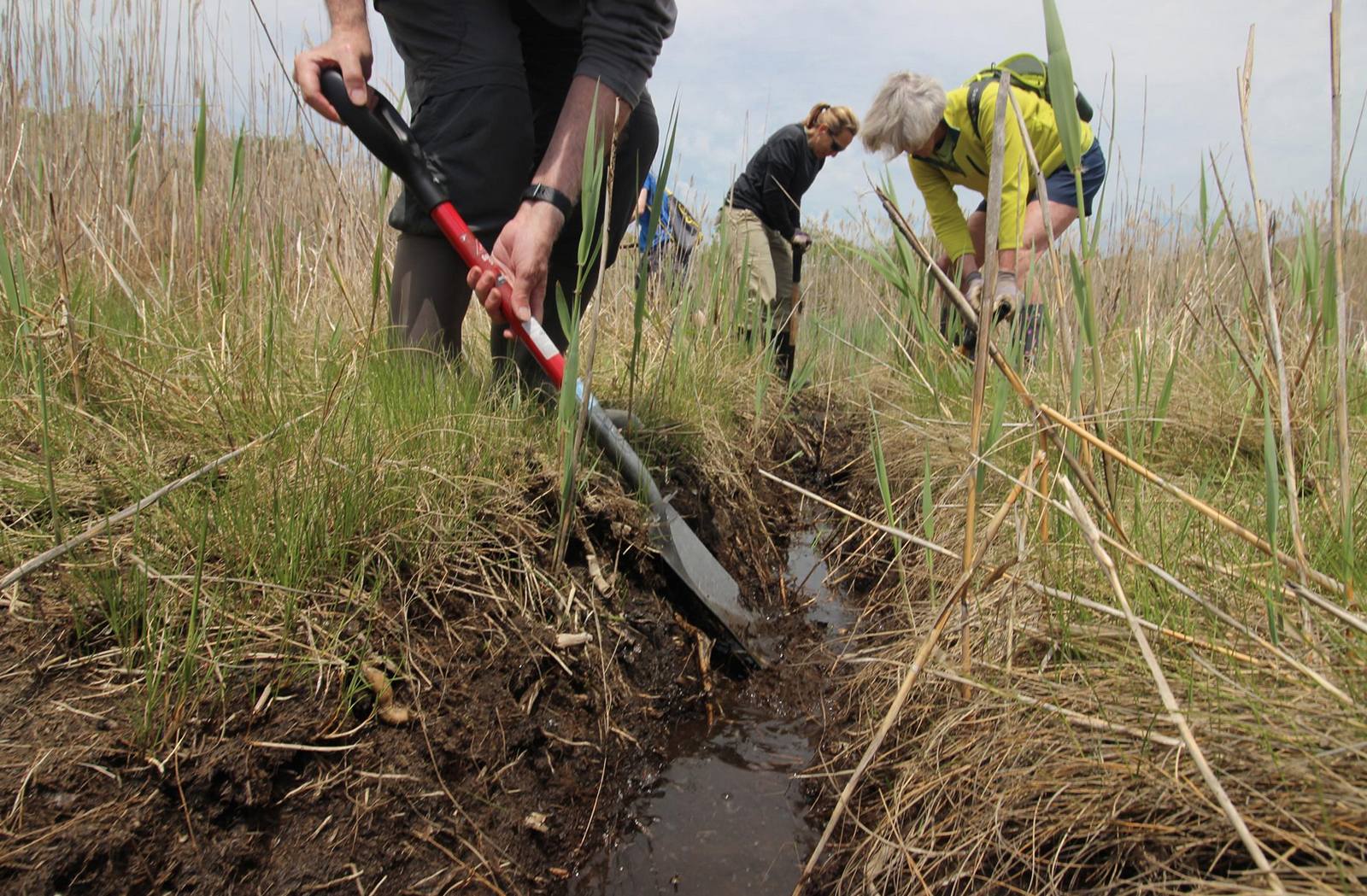
Altered state
Humankind’s ongoing manipulation of the landscape — e.g., for hundreds of years farmers altered salt marsh hydrology for hay production, according to Ferguson — isn’t limited to coastal wetlands.
Species, especially the rare ones, need specific habitat requirements — forests, vernal pools, estuaries, coldwater streams, sandplains, pitch pine barrens, Atlantic white cedar swamps, and bogs — to survive and thrive. Most of these ecosystems that remain, especially those in Rhode Island, are stressed, fragmented, and degraded. Global warming is also powering an invasion of invasives and pests that are crowding out or actively attacking native species.
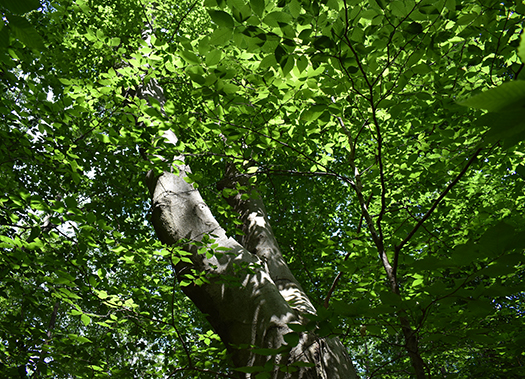
A growing number of American beech trees in Rhode Island, for example, are being ravaged by beech blight aphids. Shrubby habitat that used to feature highbush blueberry, viburnums, and sweet pepperbush, among other native species, is being replaced by such invasives as multiflora rose, Japanese knotweed, and oriental bittersweet.
Save The Bay’s McPherson said Rhode Island’s special places need protection from human overuse and from growing development pressure. She noted the state needs to better enforce the regulations adopted to protect these habitats and the creatures they support.
McPherson, a wildlife biologist who is particularly passionate about birds, began her Rhode Island fieldwork in 2001. At the onset, she often saw or at least heard bobwhite quails. She said she hasn’t even heard one in nearly 20 years.
“Habitat loss and destruction is a direct threat to all species, whether they are common or rare,” McPherson said. “When plants and trees are killed, animals are displaced. We’re seeing more human interaction with wildlife because their habitat is being squeezed.”
To loosen that vice, McPherson recommended property owners rewild their yards, or least sections of them, and said remaining natural areas, especially large ones, need to be conserved.
John Herbert, a DEM wildlife biologist, said public engagement and education are “critical to the success of keeping species from going extinct and keeping species off this list.”
Michael Healey, the agency’s chief public affairs officer, noted DEM’s Wildlife Outreach Program, created in 2017, offers teachers educational resources so they can incorporate wildlife learning into their lesson plans. Wild Rhode Island Explorer, a magazine for students published quarterly by DEM since 2019, is now also produced in Spanish.
Amanda Freitas, DEM’s community liaison for the state’s Wildlife Action Plan, noted turning off outside lights at night “is an underappreciated but an important thing we can all do.”
There has been some local environmental success in recent years. McPherson said she has witnessed the return of pileated woodpeckers, which were a rare Rhode Island sighting in the early 2000s. Herbert said the Ocean State’s piping plover population is rebounding well, even if the species’ three populations — Atlantic Coast, shoreline of the Great Lakes, and along the rivers and lakes in the Northern Great Plains — are still listed as endangered or threatened by the U.S. Fish & Wildlife Service.
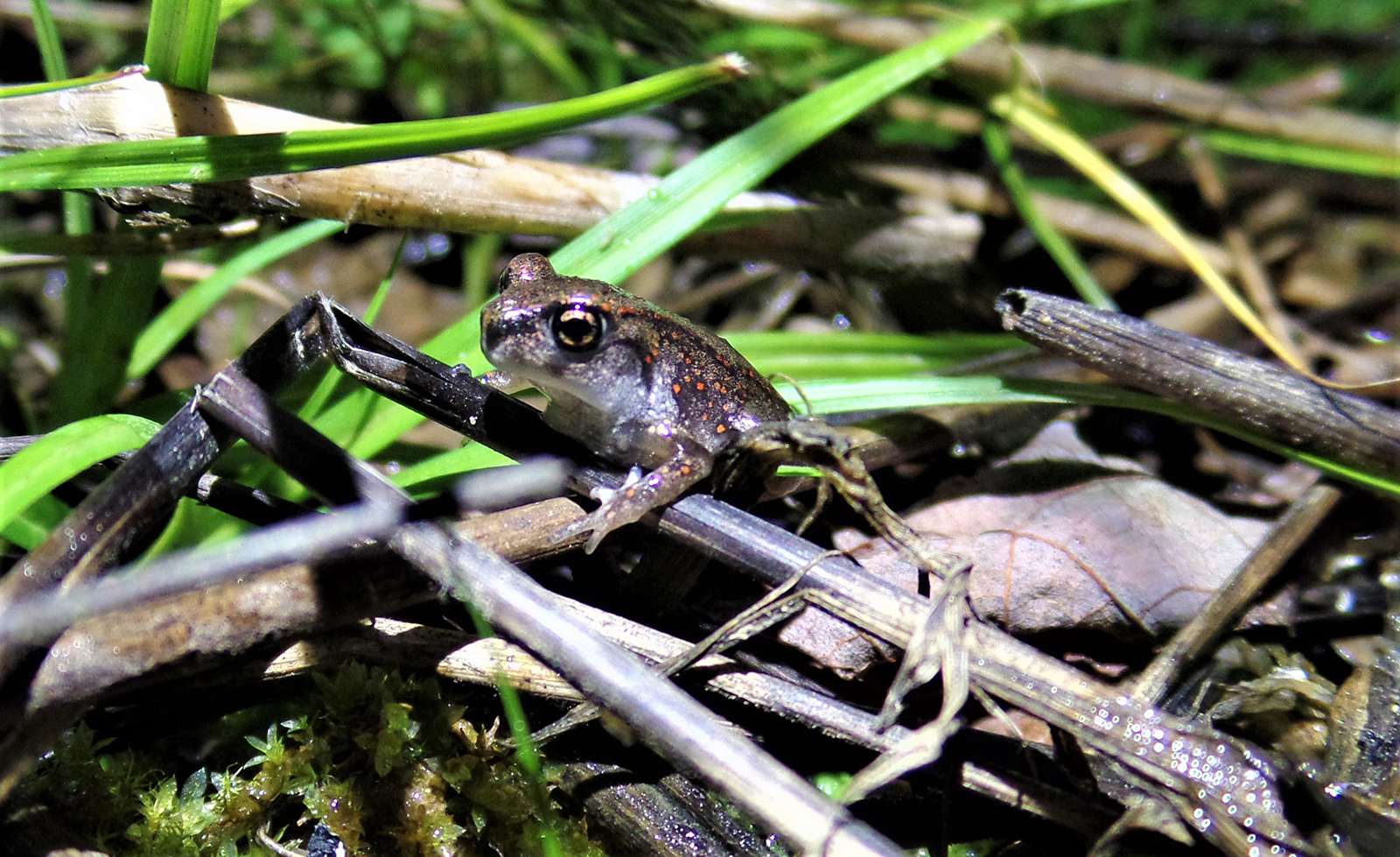
Crush of humanity
About 40 species of turtles, snakes, frogs, toads, and salamanders can be found in Rhode Island. Unfortunately, all face threats from habitat loss, pollution, invasive species, road mortality, and disease — most of these risks brought upon them by humans. Some are on the verge of disappearing from the Ocean State.
Scott Buchanan, who became the state’s first full-time herpetologist in 2018, has noted the crisis in New England is real and the mission is urgent.
“To be in herpetology is to be on the front lines of the global biodiversity crisis,” the DEM wildlife biologist told ecoRI News in 2019. “We’re at risk of losing, globally, roughly half of the reptile and amphibian species on Earth in the next 100 years. Turtles and frogs are in a neck-and-neck competition for the unfortunate title of being the most endangered wildlife taxa.”
Two species of amphibians found in Rhode Island — the eastern spadefoot toad (listed as state endangered on the Rare Native Animals of Rhode Island) and the the northern leopard frog (listed as a species of concern, but likely to be downgraded to endangered when the list is revised) — are among those facing local extinction.
The eastern spadefoot can only found at a few sites in Washington and Kent counties. These toads spend most of their lives below ground and only come out at night. With bulging eyes and a spade-shaped protrusion on their feet for digging, they are most noticeable when they are calling from their breeding pools in early summer after having emerged from their woodland burrows to mate and lay eggs. But the shallow-water wetlands the species needs to breed are being drained and filled.
Efforts, however, are ongoing to create habitat to establish additional populations before the toad disappears from Rhode Island. Last September conservationists and volunteers rescued some 1,000 spadefoot tadpoles from a breeding wetland that was at immediate risk of drying out. The tadpoles were raised to metamorph-stage “toadlets” under the care of Lou Perrotti, director of conservation at the Roger Williams Park Zoo, and, after being screened for disease, were released at three sites that have been targeted for spadefoot toad restoration.
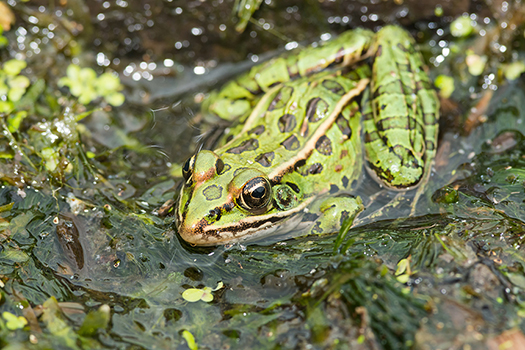
The northern leopard frog is found only on the border of Bristol and Warren, and Buchanan said there is little that can be done to help it recover.
“The northern leopard frog might be the best example of a species that’s about to disappear from the state,” he told ecoRI News three years ago. “It could happen this year, next year, or in five years, but all indications are it’s going to happen soon. And there’s not a tool in my toolbox at the moment that I can use to confront the situation.”
Turtles, such as the state endangered northern diamondback terrapin, also face high demand from poachers for the pet trade. Northern diamondback terrapins are the only turtle in the region that lives in salt marshes and brackish waters and two years ago, in a bit of rare good news for Rhode Island’s endangered species, volunteers scouting for new populations of the state’s rarest turtle turned up 15 new sites hosting diamondback terrapins.
Despite the new populations, however, Buchanan has said the turtles are no less threatened than they were before the new populations were discovered. He noted there is little information about these new sites, like how many turtles are there, whether they are successfully breeding, or whether they are established populations.
Prior to 1990, when a population of the turtles was discovered in Barrington, no one had seen a terrapin in Rhode Island for years.
The global population of North Atlantic right whales, which migrate through Rhode Island waters, has dropped from an estimated 348 to 340 animals, according to the North Atlantic Right Whale Consortium.

Scott Olszewski, DEM’s deputy chief of marine fisheries, said the right whale is the region’s most at-risk marine mammal. He also noted another marine species, the Atlantic sturgeon, will likely appear on an updated Rare Native Animals of Rhode Island list.
Every October, the North Atlantic Right Whale Consortium, in partnership with the Anderson Cabot Center for Ocean Life at the New England Aquarium, releases a preview of its annual report card on the status of right whales, including population estimates for the critically endangered species.
Although no right whale deaths have been documented to date this year, this encouraging news is tempered by the fact that entanglements in fishing gear, vessel strikes, and the shifting distribution of food sources caused by climate change have resulted in the species’ continued decline for more than a decade.
“The current population estimate represents an ongoing downward trend amid concerns that human impacts on right whales are affecting the animals’ ability to survive and reproduce,” according to the consortium.
The global population of North Atlantic right whales was growing steadily in the 1990s and 2000s, including a record year in 2009 when 39 calves were born. But reproduction rates have slowed precipitously since then. In 2018, for example, the North Atlantic right whale population produced zero calves for the first time on record.
Fishing gear is blamed for nearly 60% of right whale deaths since 2009, according to the New England Aquarium, but efforts are ongoing in both the U.S. and Canada to reduce such fatalities.
Canadian fishermen have tested buoyless technology to reduce entanglements with whales. Massachusetts has tested new gear for lobster fishing. The system relies on a passive buoy that floats to the surface when a fisherman sends a signal to the trap anchored to the seafloor. However, there has been pushback from the commercial fishing industry over cost.




While updating the list of RI endangered species is important, it is meaningless unless the ecosystems where those animals live are protected in their natural state. For example, most of our natural heritage areas are not protected whatsoever. There is a way to do this though which is outlined in the Natural Areas Protection Act of 1993. In the Act, it creates a process to designate our most valuable ecosystems as Natural Area Preserves which is the highest level of protection for a forest in the state. For some reason, no natural area preserves have been designated in almost 30 years, if ever. I don’t even want to think of how many forests with endangered species have been destroyed in the last 30 years to development and timber harvesting. Even on public land. However, we can get back on the right track now and start designating these rare ecosystems as natural area preserves so the endangered species in them and our natural heritage areas will be permanently protected in their natural state. That means no timber harvesting in these areas as forest management would make the forest no longer suitable to the endangered species that live there. The most perfect ecosystems are those untouched by humans and left to be shaped by nature.
Maybe this is how it’s done, but it seems crazy to me that we should have to apply for a grant to make sure we keep track of threatened species in Rhode Island. Massachusetts doesn’t seem to have to resort to this.
This should be a properly funded and have the manpower to accomplish this daunting task. We can not kick the can down the road any longer.
If it is going to take legislation to get get this done let’s find out what legislation us needed and get it passed an implemented.
It seems to me that survival of all our diverse flora and fauna should be a priority if DEM if not why not?
I realize that DEM has been under funded and undermanned for many years.
Let’s give our conservation workers the tools they need to accomplish their mission.
Frank, good series of articles focusing on biodiversity, but as you might expect I do need to make some clarifications. This is not so much you misinterpreting information. Rather, it is the information you are getting from personages who have little background in biodiversity or rare species, and no memory of some amorphous entity known as the Natural Heritage Program that apparently once existed in Rhode Island.
But before I go there, a bit of review so we are all on the same page. The Rhode Island Natural Heritage Program was established in October 1978 under a cooperative agreement between DEM and The Nature Conservancy. Rhode Island was the 21st state program as part of TNC’s Natural Heritage Network that would eventually include all 50 US states and most Canadian provinces. Each state program assessed the biodiversity within its’ respective borders to determine which species/ecosystems were the rarest and most vulnerable to extirpation. Each state program prepared lists of rare plant and animal species that would serve as the basis for a comprehensive National Biodiversity Conservation Database.
The national TNC Science Department, in Arlington, VA, coordinated the network, ensuring that each program used the same database structure, which evolved over time and is today coordinated by a separate nonprofit organization called Natureserve.
The database provided the basis for the first national assessment of biodiversity in the 90s which identified biodiversity hotspots throughout North America. The same kinds of analyses were conducted within each state to identify similar concentrations of rare species and associated ecosystems. In Rhode Island, the NHP’s first Technical Report in 1981 identified more than 20 sites that harbored some of the states’ rarest biological elements.
In the early 90s, TNC conducted additional analyses and prepared Conservation Plans for five priority regions in the state for biodiversity conservation, including Block Island, Tiverton/Little Compton, Pawcatuck River Watershed, South Shore, and Northwest Forest. These plans included extensive mapping of biological resources, with identification of critical habitats and buffers, that served as conservation targets for land acquisition, including State Open Space funds.
In addition to guiding conservation, when the Rhode Island program was less than 3 months old, it participated in its first environmental review of the impacts of construction activities on biodiversity. In this instance, the program convinced DEM engineers to realign the proposed entrance road at Beavertail State Park to protect a rare plant population. During 28 years, the program reviewed thousands of projects, environmental impact statements, ecological assessments, management plans, open space grants, and anything else that required a determination of impacts to biological resources.
In the mind of government, biodiversity protection is a luxury. It’s fine when the area in question is a bog, or any land that doesn’t provide an opportunity for development, or doesn’t allow the extraction of a natural resource.. But, when biodiversity conservation planners began stressing the value of large tracts of forest land for protecting forest biodiversity, that meant targeting developable land. You can fill in the rest of the story, but when the NHP was dissolved in 2007 there was no interest at DEM to continue it. So, no more environmental review. Projects like the Tiverton Casino and Citizen’s Center in Johnston were not reviewed, and most notably the Clear River Energy Center in Burrillville was not reviewed for natural heritage data – even though the Division of Fish and Wildlife was specifically requested to do so by the Energy Facility Siting Board.
And, when it was learned that the proposed site of the power plant was within the area designated by TNC in its Northwest Forest Conservation Plan, the organization denied that impacts to biodiversity was cause for concern, even though Invenergy’s own environmental consultants found 17 Natural Heritage species at the project site, including the State Endangered Cerulean Warbler.
Should it be surprising that nobody knows anything about the Natural Heritage Program? DEM and TNC have spent years denying it ever existed.
Should it be surprising to see statements like:
“Kate McPherson, the Narragansett Bay riverkeeper for Save The Bay, recently told ecoRI News that Rhode Island can’t offer any real protection “if we don’t know what needs to be protected.” She said updating the rare species lists would be “super helpful.”
I hope these brief comments will help Kate and others understand that we do know what needs to be protected, and in most cases we know what to do. When dealing with natural ecosystems and the biodiversity they harbor, the best approach is to allow Nature to take its course. The obvious example, forests need to grow to maturity in order to provide for the highest levels of biodiversity. Cutting down forests to benefit game wildlife not only prioritizes the wrong species, but destroys the biodiversity of the forest being cut down. Hence, we should continue to be disturbed by statements like this from DEM:
“Michael Healey, the agency’s chief public affairs officer, noted DEM’s Wildlife Outreach Program, created in 2017, offers teachers educational resources so they can incorporate wildlife learning into their lesson plans.”
I wonder what question Healey is responding to. Is he saying that the DEM wildlife outreach program is an appropriate substitute for learning about biodiversity? Because it is definitely not – in fact, it’s a good resource for teachers to use as part of a biodiversity curriculum as an example of what not to do to protect biodiversity.
Finally, one last bit of housekeeping.
“When a species naturally part of Rhode Island’s biota is in danger of local extinction, state law (RIGL 20-37-2) allows the Department of Environmental Management (DEM) to place it on the natural heritage list.” And from David Gregg at the Natural History Survey, “the Survey doesn’t have the power to add or remove species from the list.”
There has always been confusion about the Natural Heritage Lists. Each species on the rare plant and animal lists were assigned status codes accordingly: State Endangered, State Threatened, Concern, Historic, and Extirpated. RIGL 20-37-2 is the RI Endangered Species Act that codified the identification of State Endangered plants and animals as those listed Federally as Endangered or Threatened, or those so declared by the Director of DEM. All other species on the natural heritage lists were determined by the program. But, because the only protection afforded under the Rhode Island ES Act was from collection, and the Act was not regulatory like the Wetlands Act, the NHP simply served as the Director’s agent and assigned State Endangered status when appropriate.